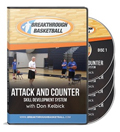How To Actually "Teach" During A Skill Development Workout
There is more to being a skill development coach than just putting together some drills and giving players a workout.
You hear and read all the time about what a coach must bring to every workout or training session. A coach must show passion, bring energy, and motivate his/her players.
Those are good qualities to have as a coach, but there is one thing coaches must remember....
You must be able to teach.
You must know how to instruct a player and take him/her from point A to point B. There are some simple steps to follow that I will discuss in the article.
I believe if you follow these steps you will become a better teacher, which will produce better players.
5 Teaching Steps:
Demonstrate/Explain – A detailed and clear explanation of what you want the player to do. Different people learn different ways. Some need a demonstration (visual learners) while others just need it explained. Either way, make sure you keep it simple.
Imitate/Interpret – Before I allow a player to go through a drill or even after I explain why we are doing something, I always ask for feedback. If the player(s) don’t have any questions, I then ask them questions. I do this to take the guesswork out. A lot of times players will have questions but won’t ask because they don’t want to ask a stupid question. I don’t believe in stupid questions during my training sessions. I always assume, no matter whom I’m training, they don’t know anything about basketball.
Feedback – After the player has imitated the drill or skill, I give them immediate feedback. I let them know what was good, what needed improving, etc. This is critical in skill development. Players must know how they are progressing. Feedback can be verbal, visual (video or pictures), or written.
Correction (if needed, repeat steps 1 & 2) – After I give my player(s) feedback I determine if steps 1 and 2 need to be repeated. If they need to correct something then I will demonstrate again or have another player demonstrate. I will then ask the player more questions about what they are doing to make sure they understand what I expect from them. After they imitate the skill for a second time, I give them more feedback. If they were able to perform the skill we move on. If they still struggled with the skill, I will breakdown the technique even more to make sure they get it. This may be walking through it or performing it without a ball.
Reinforce – If the player can imitate the skill, I give them positive reinforcement and we make sure to get plenty of reps.
Additional teaching tips
Know their interest outside of basketball – I use this a lot with my players. I like to know what music they listen to, movies/tv shows they watch, and other sports they play so I can reference those things when teaching them.
Give them an explanation – You’ll have players that will do whatever you ask them to do, but in the back of their mind they will be wondering why in the world am I doing this. A quick explanation of why they have to scoop the ball out of the chair before they shoot or why they have to get the tennis ball off the floor while dribbling will keep them interested in the drill. Plus, if they know why they are getting the tennis ball off the floor they will more than likely give more effort.
Show support – Players sometimes don’t see the big picture. When learning a new skill sometimes you have to take a step back to take 2 steps forward. During that time you have to show the player patience and support. Encourage them during the tough times. I tell my players all the time if being good/great/elite was easy then everyone would be good/great/elite.
Have good body language – Show the player you are into the workout by your actions. Use your hands, facial expressions, and body language to motivate and encourage. If they do something right, give them a high five, clap for them, or give them some dap.
Be confident when speaking – You know what you are talking about. Speak clearly, confident, and look them in the eyes. Talk with your head up, back straight and shoulders back. Command their attention.
Don’t lecture – Keep your statements short and to the point during the workout. Save your lengthy speeches for before or after practice. Give players bullet points and coach on the fly during the workout. Summarize statements, but at the same time be very detailed.
These are some tips I use when teaching during a skill development workout. I’m sure there are some other great tips out there that can make you a better coach and teacher. Remember every player is different. Some players need a rowdy coach to get in their face to motivate them and others just may need some encouraging words. So most importantly, know your players and know how to reach them.
Recommended DVD's & eBook:

|
The Attack & Counter Skill Development System This eBook & DVD's will improve your shooting, ballhandling, footwork, perimeter moves, post moves, finishing, aggressiveness, quickness, confidence, mentality, and your all-around game! Designed by NBA skills coach Don Kelbick, this unique and comprehensive system is incredibly simple when compared to other skill development programs. Yet it works with NBA and pro players at the highest level... (more info) |
What do you think? Let us know by leaving your comments, suggestions, and questions...
|
|||||||||||||||||||



 Facebook (127k Followers)
Facebook (127k Followers) YouTube (141k Subscribers)
YouTube (141k Subscribers) Twitter (31.8k Followers)
Twitter (31.8k Followers) Q&A Forum
Q&A Forum Podcasts
Podcasts